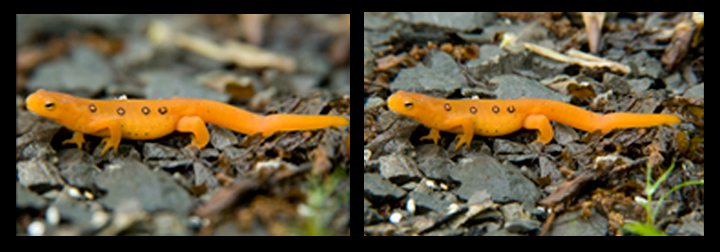This is an inukshuk atop Mount Whistler in Bristish columbia. Although you might not know what an inukshuk is, you might recognize it as it was part of the logo for the 2010 Winter Olympics held in Vancouver British Columbia.
This is what I refer to as a “just missed it” image. At first glance it is somewhat interesting. Because the bottom rocks blend into the hills in the background, it is hard to grasp that the stones are the main subject in the image. You really have to look at the image to recognize that this is a small inukshuk. In comparison, look how the top two stones stick out from the snow capped mountain in the background. This would have been a much nicer image if I had gotten lower so that the entire inukshuk was silhouetted by the snow capped mountains and the gray sky.
The lesson here is that you should always pay attention to your background when photographing outdoors. Nothing ruins an image more than having a car sticking out the side of your subject, or a person wearing a yellow shirt walking in the background. Both of these are bound to distract the viewers eyes from the true subject of your image. So before you trip the shutter release, look around your subject for distracting shapes or colors. If need be, wait a few minutes or change position to get rid of those distracting background elements.
I took this picture at the puffin sanctuary on Machias Seal Island. For those who have not heard of it, Machias Seal Island is a two hour boat ride from Jonesport, Maine. On this day, the water was rough with low ceilings. As we landed on the island the tour operator noted that, because of the weather, we might not get the full hour on the island as advertised.
When I first entered the blind, the other photographer immediately started into rapid fire photography. I soon realized that since time might be extremely limited, I had better start shooting quicker. After 28 minutes and two and a half memory cards, the guide returned and said we had to leave immediately. During that 28 minutes I had shot 415 images. Of course, many of them were not useable, but this is one of a number of keepers.
This image is particularly interesting as it looks like the puffins are posing in a studio. During my time in the blind, the puffins rarely stood still. This particular rock was the highest point in a pile of rocks and the puffins took turns hopping up one side, looking around, and hopping down the other side. At times there would be two puffins on the rock, and for very short periods of time three would crowd the top of the rock. At the moment I took this image, the puffins appeared to be looking across the ocean at something of interest. The gray background highlights the silhouette of the puffins, making them really stand out.
Oh yeah, my wife was on the trip with me and ended up “feeding the fishes” just before we reached the island. After the short time on dry land, she was less than thrilled to get back on the boat for the trip back to Jonesport!
Click here to book your trip with Captain Ira aboard the Chieftain. On the way out to the island you can talk to Captain Ira about the history and current state of the fishing industry in Maine. If you book a tour, contact me and I can give you more tips so that you can maximize your time on the island.
Simply put, Depth of Field is the amount of the image that is in sharp focus. In the images above, the one on the left has a “shallower” depth of field. Note that the small green plant in the right foreground and the rocks in the background are blurred. The image on the right has a “deeper” depth of field since the small green plant is somewhat more in focus as are the rocks behind the salamander.
The aperture setting on your camera controls depth of field. The smaller the aperture, the more depth of field. I took the image on the left using an aperture of f/5.6 while the one on the right was taken with an aperture of f/22. (Confusing to the novice, but an aperture of f/22 is smaller than an aperture of f/5.6).
So what does depth of field mean to your outdoor photography? Use your aperture setting to highlight a subject or isolate it from the background. In the image on the right, the rocks in the background and the small plant distract the viewers eyes from the salamander which is the main subject. By reducing depth of field the viewer is drawn to the salamander.
Which image do you like better?
Click here is a more technical tutorial on depth of field.




